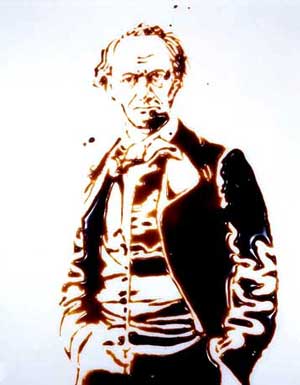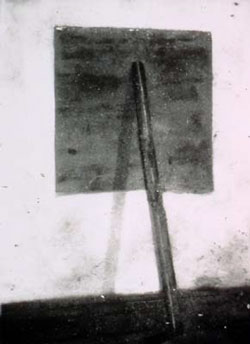The New York-based Brazilian artist Vik Muniz rose to international fame by poignantly and thoroughly manipulating the ways in which we perceive visual information. His photographs of impeccably crafted, illusionistic tableaux singled him out as one of the most thoughtful and engaging photographer/artists of the 1990s.
His best known series, Pictures of Chocolate (1997-98), were startlingly accurate renderings of well-known photographs of Jackson Pollock action painting, Sigmund Freud, The Last Supper, and Harold Edgerton’s strobic glimpse of a milk drop — all drawn in Bosco syrup. For Pictures of Thread (1995-98), Muniz re-drew classical Pastoral landscapes by Claude Lorrain, Gustave Corot, and others, constructing each image with thousands of yards of thread, exquisitely placed, clumped, and laid out to create dense new views of familiar scenes. He has also crafted delicate line “drawings” from wire; dark and moody still-lives in soil; and from cottonballs, clouds that look like kitties and teapots floating by.
One constant in these works is that each image is ultimately presented in photographic form. Not only would it be impossible to store and transport his drawings made of sugar or spaghetti sauce, but by photographing these images, he adds another layer of representational distance between the viewer and the picture. Muniz is ultimately interested in our process of digesting and reconstructing imagery and the boundaries of pictorial representation. As has said, “I want to make the worst possible illusion that will still fool the eyes of the average person…Illusions as bad as mine make people aware of the fallacies of visual information and the pleasure to be derived from such fallacies.”* In this, Muniz takes his place as heir apparent to the crafty photographic jousters Duane Michals, Zeke Berman, and William Wegman. Perhaps only the Spaniard Chema Madoz can give Muniz a run for his money as contemporary master of (dis)illusion.
It was with much anticipation, then, that the Menil Collection announced that Muniz would be creating a new body of work specific to the museum in conjunction with FotoFest 2002. During a visit to Houston to discuss possibilities for the exhibition, Muniz came upon a most wonderful item indeed — a miniature, hand crafted maquette of the Menil, complete with tiny reproductions of nearly every painting, sculpture, and object in the collection, hand crafted by Mark Flood, Doug Laguarta, and David Warren (who ultimately deserve more credit for this exhibition than they receive). Many museums use these sorts of models to assist in laying out shows and visualizing gallery configurations, but the Menil’s is especially stimulating in that every little Warhol, Tanguy, and Cycladic figure have been drawn or sculpted by hand, rather than photocopied. It’s a wonderous thing to behold, and right up Vik’s alley. They say that upon seeing the maquette, the decision was all but cinched: the exhibit would focus on the museum by way of this little model. Not only was Muniz’s source material readymade, but it seems as if the concept was sitting right there as well, just waiting to be picked up.
Unfortunately, the fun stops here, and the rest is simply an academic execution of the obvious conclusion. In short, Muniz photographed a gallery’s worth of the “model pictures” from the maquette and enlarged those photos to the size of the original artwork. What appears at a (very) quick glance, then, to be a Magritte painting on the wall is only an enlarged view of the rough yet precise color sketch done by one of the guys on the mini-Menilville staff. It is moderately interesting to see what was changed or left out when the miniaturists condensed the artworks to thumbnail size. For the most part, they are terrific copies, and their creator’s jobs sound like an art school fantasy. Seeing Muniz’s large versions of the miniature is less rewarding than viewing the actual maquette, though – but fear not — it, too, is included in the exhibit. The model for that particular gallery sits in the middle of the room, with the same show on view and everything (the original model pictures that Muniz enlarged). Since the maquette is faithful to the gallery, right down to the vents in the floorboards, there is a mini-model in the little gallery and an even tinier one inside of that. On paper, it sounds as if it could be a Borges-like, looking glass collapse of time and space or something, but in reality it’s only conceptual scaffolding.
Any review of Model Pictures should mention that most of the artworks re-re-presented in the exhibit are from the museum’s Surrealist collection, not only because that’s the Menil’s stronghold, but also because ‘surrealism itself was a movement very concerned with the relationship between the mind and visual phenomena.”** That is more conceptually sound than doing a Menil’s Greatest Hits show, I suppose, but the selection of artwork presented herein is completely ancillary to the concept and process of the exhibit itself.
The point is, he’s taken shrunken objects and blown them back up to original size. That’s it. Just like when Charles Ray took a little Tonka truck, assembled a full-scale reproduction of it, and parked it in front of the Whitney for the 1993 Biennial. Except less cool. Far, far less cool.
Unfortunately for Houston, this is Muniz Lite. Model Pictures lacks the warmth, wit, and especially the jaw-dropping techniques of his earlier work that catapulted him to the head of his class. Muniz’s art has always had a magical “wow”-inducing element that is entirely absent from this show. It’s time for the artist to get back to the studio, get his hands dirty again, and forget this show ever happened, just as future historians surely will when they look back on Muniz’s career.
Chas Bowie is an artist and writer in Houston.






